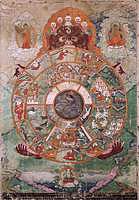
|
Wheel of Life (painting no. 591)
|

View Larger Image |
||||||||||||||
|
The Wheel of Existence/Life (Tibetan: sid pa’i korlo, Sanskrit: bhava cakra). The large red figure of a personified Samsara (cyclic existence), wrathful, with one face and two hands, a crown of skulls and flaming orange hair is holding the circular wheel of existence pressed up against the mouth ready to be swallowed at any moment - representing the immediacy of impermanence. This wrathful figure is sometimes referred to as Yama, the Lord of Death, and at other times as the red female daemon of death, possibly Yami, the sister of Yama. To the left side is a small standing Shakyamuni buddha and to the right is a seated Maitreya; the next buddha of this age. At the bottom of the painting is Sadaksari Avalokitesvara, white, with one face and four hands. In the center of the wheel are the three poisons represented by three animals, a black pig (ignorance), snake (anger) and a rooster (desire) circling on a black background. The surrounding circle composed of a top white half and a black bottom half, shows those individuals collecting and expending actions (karma) moving upward in the circle of existence and then having exhausted that merit moving downward. Outside of that is a circle of five sections portraying the six realms of existence; god, asura (anti-gods), human, animal, ghost (preta) and hell. Each separated by an orange dividing line. At the top and to the left is the Realm of Gods and Asuras, grouped together, highlighted by a heavenly being in a palace and below that - fighting between the two groups. To the right is the Human Realm with three figures and a cluster of buildings. To the lower left is the Animal Realm represented by various four-legged creatures. To the lower right is the Realm of Pretas represented by four naked ghostly figures breathing fire from their mouths. At the bottom is the Hell Realm with the central wrathful figure of Yama Dharmaraja, the Lord of the Dead, King of Judgement (the Law of Karma), holding a stick in the right hand and a mirror in the left to reflect the actions (and consequences) performed by each individual that comes before him. The outermost circle is composed of 12 scenes which represent the Twelve links of Dependant Arising starting at the top and moving in a clockwise direction; a blind man guided by a stick (#1 ignorance), a potter (#2 mental formations), monkey (#3 consciousness based on causality), travelling in a boat (# 4 name and form), an empty house with windows (#5 the six senses), a couple embracing (#6 contact), an arrow in the eye (#7 sensation), drinking alcohol (#8 craving), a monkey picking fruit (#9 grasping), a couple joined in intercourse (#10 becoming), a woman giving birth (#11 birth), and finally a figure carrying a bundled up corpse to the funeral pyre (#12 old age and death). Yama the Lord of Death, although portrayed in the Hell Realms, actually resides in the Realm of Ghosts and is the King of the Pretas. He lives in the Preta city of Kapila 500 miles below the classical North Indian city of Rajgir and is accompanied by 36 attendants. His association with the Hell Realms is in the capacity of a judge of karma. This model of Buddhist cosmology, focusing on the inhabitants, is based on the Abhidharma literature of the Theravada and Sutrayana vehicles. Within the Vajrayana system various divergent models are presented with the foremost being that of the Kalacakra Tantra. Along the bottom are verses written in gold in the old ornate ‘lan tsa’ script of Nepal. The background landscape and colours indicate an Eastern Tibetan style of painting. J.Watt 8-98
|
|||||||||||||||
Photographed Image Copyright © 1998 Shelley & Donald Rubin Foundation
|
|
| |
Next Image |